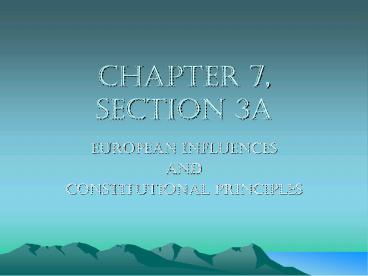Chapter 7, section 3a - PowerPoint PPT Presentation
1 / 17
Title:
Chapter 7, section 3a
Description:
Chapter 7, section 3a European influences and Constitutional principles Content Vocabulary An example of an amendment to the Constitution is the Bill of Rights. – PowerPoint PPT presentation
Number of Views:92
Avg rating:3.0/5.0
Title: Chapter 7, section 3a
1
Chapter 7, section 3a
- European influences
- and
- Constitutional principles
2
Content Vocabulary
- An example of an amendment to the Constitution is
the Bill of Rights. - The branch of the government that establishes
laws is the Legislative Branch. - The political feature of the United States
government whereby power is shared between the
federal and the state governments is called
federalism.
3
- The checks and balance system was established so
that no single branch can dominate the
government. - The branch of the government headed by the
President is the Executive Branch. - The Supreme Court is a part of the Judicial
Branch of the government. - The President and Vice-President are elected by a
group of presidential electors called the
Electoral College.
4
8. Name 2 of the Enlightenment thinkers and
explain eachs important ideas.
- John Locke
- All people have natural rights (Life, Liberty,
and property) - Government is a contract between the people and
their government - The governments power should be limited
5
- Baron de Montesquieu
- Powers in the government should be separated and
balanced. - This would prevent any single person or group
from gaining too much power - Powers should be clearly defined and limited.
6
9. 5 Principles of the Government
- FEDERALISM
- Calls for the division and sharing of powers
between the federal (national) government and the
state governments - Federal powers State powers
- Maintain an army / navy establish schools
- Foreign affairs laws regarding marriage
and divorce - Postal routes
- Coin money Shared powers
- Punish counterfeiting Taxes
punish piracy
General welfare - Build roads
7
B. Separation of Powers
- The division of the operations of the national
government into 3 branches, each with its own
powers and responsibilities - Legislative Branch (Congress) makes the laws
- Collect taxes
- Regulate foreign and interstate trade
- Raise and support a military
- Establish post offices
- Establish a federal court system
8
- Executive Branch (President) carries out the laws
- Commander-in-chief of the armed forces
- Directs foreign relations
- Grants pardons and reprieves
- Appoints Supreme Ct. Justices (with 2/3 consent
of the Senate) - Makes treaties (with 2/3 consent of the Senate)
9
- Judicial Branch (Supreme Court) settles arguments
- Constitutional cases
- Disputes between states
- Disputes with a foreign country
- Maritime cases
- Disputes between a person and a foreign country
10
c. Checks and Balance System
- The means by which each branch of the national
government is able to check, or control, the
power of the other 2 branches - The framers of the Constitution hoped to keep any
one branch from gaining too much power - The President can check Congress by vetoing a
bill - The Supreme Court can check the President and
Congress by declaring a law unconstitutional
11
- The Senate must approve treaties signed by the
President - Congress can override a Presidential veto
- Congress can impeach and convict high officers in
the government. - Congress can amend the Constitution to over-rule
the Supreme Court
12
d. Popular Sovereignty
- Popular sovereignty means that the people hold
the final authority, or ruling power thru
voting - The framers of the Constitution believed that a
contract exists between the people and the
government. - The government receives the power to rule from
the people.
13
- 4. The people exercise their power by voting.
- In 1789, only white men over age 21 and owned
property could vote. - In 1870, Amendment 15 was passed giving Black men
the right to vote, and - In 1920, Amendment 19 gave women the right to
vote.
14
- Examples of issues We the people can vote on
are - Governorships
- Representatives
- Senators
- Electors who choose the President/Vice-President
- Re-call petitions
15
e. Limited Government
- The Principle that the government is not all
powerful but can do only what the people say it
can do example Bill of Rights - The most important limits on government are set
out in the Bill of Rights - Freedom of religion, speech, press, assembly,
and petition - The right to keep and bear arms
16
- The right not to have troops quartered in our
homes in peacetime - The right not to have unreasonable search and
seizure - The right not to have double jeopardy, be a
witness against ourselves, and have due process
of law - The right to a speedy and public trial, be
informed of the offense, be confronted with the
witnesses against us, and to have a lawyer
17
- The right to a trial by jury
- The right not to have excessive bail or cruel and
unusual punishments































